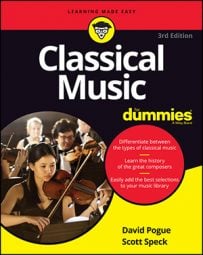In olden days, classical music composers were expected to fit their works into a predetermined structure — sonata form, for example, or rondo form. These forms were fixed, rigid, and considered almost sacred. If composers felt the urge to let their imaginations run wild, their only recourse was to write in yet another form: the most formless of all forms, the fantasia.
Because the composition was named a fantasy (which originally meant imagination), the composer was liberated from the normal constraints of musical form. The composer couldn’t be accused of violating some sacred musical structure, because fantasias didn’t have one.
In a typical fantasy, the composer sets out a musical theme at or near the beginning. The rest of the piece is a musing on that theme; the composer goes wherever he feels like with it. Ralph Vaughan Williams (1872–1958) used the tune “Greensleeves” as the beginning and ending of his short, rapturous Fantasia on Greensleeves.
Fantasies usually contain lots of little notes, seemingly in a free rhythm. After a theme is established, a solo instrument usually goes off on a flight of fancy, scurrying up and down the scale at a breathless pace. One of the greatest composers, Johann Sebastian Bach (1685–1750) — who was also the greatest organist of his day — wrote several fantasies for organ in which he sent the organist’s fingers flying all across the keyboard.
Actually, most fantasias aren’t completely formless; they’re just less strict than other forms. Because most great composers spent many years studying and working out extremely rigid compositional exercises, only the rare composer could divorce himself from all this structural discipline. Beethoven’s Choral Fantasy, for example, is free but nevertheless logically structured. And the first movement of his famous Moonlight Sonata for piano bears the subtitle “Quasi una fantasia” — “almost a fantasy.”
A rhapsody is along the same lines as a fantasy, with a similarly free structure. Most rhapsodies date from the late Romantic era (the mid-1800s into the 20th century). The famous pianist Franz Liszt wrote several Hungarian rhapsodies for the piano. (These days, you may hear them arranged for full orchestra.)
In these pieces, he takes simple, Hungarian-sounding themes and turns them into a tornado of virtuosic vigor. And if you’re a classic rock fan, Queen’s “Bohemian Rhapsody,” featured so prominently in the movie Wayne’s World, is, yes, a genuine rhapsody — a freeform rush of different musical ideas, one after another.

